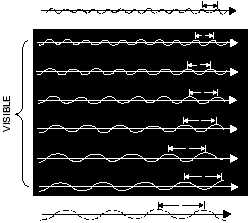Theory
When light is emitted from a source, waves of
radiation travel in straight lines and in all directions.
Dropping a pebble into a pool of water can see a simple
example of motion, similar to that of radiation waves.
The waves spread out in expanding circles; similarly,
light waves spread out in all directions to form a sphere.
The boundary formed by each wave is called a wave
front. Lines, or rays, drawn from the light source to any
point on one of these waves indicate the direction in
which the wave fronts are moving. Light radiates from
its source in all directions until absorbed or diverted by
coming in contact with some substance or object.
Wavelength
The wavelength of a light wave is the distance from
the crest of one wave to the crest of the following wave.
Wavelength, frequency (the number of waves which
pass a given point in a unit of time), and speed are
related by the simple equation:
C = lF
Where:
C = speed
l = wavelength
F = frequency
Because the speed of electromagnetic energy is
constant, the frequency must increase if the wavelength
decreases and vice versa.
Wavelength is measured in angstrom units (A).
They may also be measured in millimicrons, or
millionths of millimeters (mA). Figures 5-7 and 5-8
show the visible and invisible spectrum’s colors in
relation to their wavelengths. Figure 5-8 shows that the
visible spectrum occupies only a small portion of the
complete electromagnetic spectrum extending between
4,000 and 7,000 angstroms only.
5-14
L
L
L
L
L
L
L
L
ULTRAVIOLET
VIOLET
BLUE
GREEN
YELLOW
ORANGE
RED
INFRARED
AG5f0507
Figure 5-7.—Wavelength of various visible and invisible
colors.
AG5f0508
REFRACTION OF LIGHT BY A PRISM.
THE LONGEST RAYS ARE INFRARED; THE SHORTEST, ULTRAVIOLET.
10
10
10
10
10
10
10
10
10
10
10
-6
-4
-2
2
4
6
8
10
12
14
16
1
COSMIC
RAYS
GAMMA
RAYS
X RAYS
ULTRA-
VIOLET
RAYS
INFRA-
RED
RAYS
HERTZIAN
WAVES
RADIO
WAVES
LONG
ELECTRICAL
OSCILLATIONS
VISIBLE SPECTRUM
WAVELENGTHS IN MILLIMICRONS
Figure 5-8.—Wavelengths and refraction.



